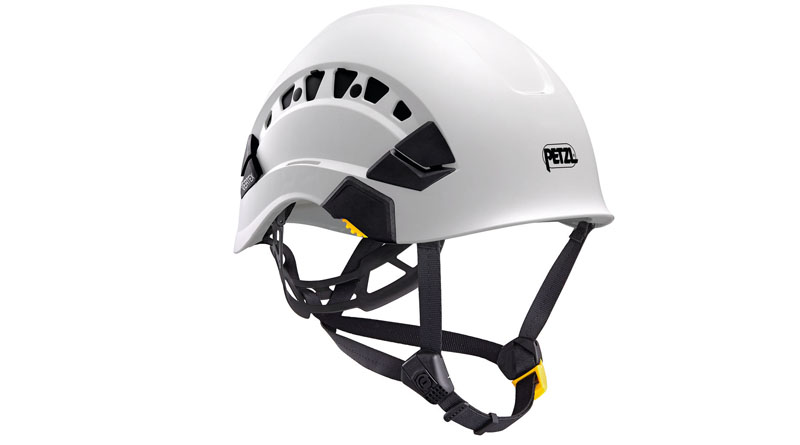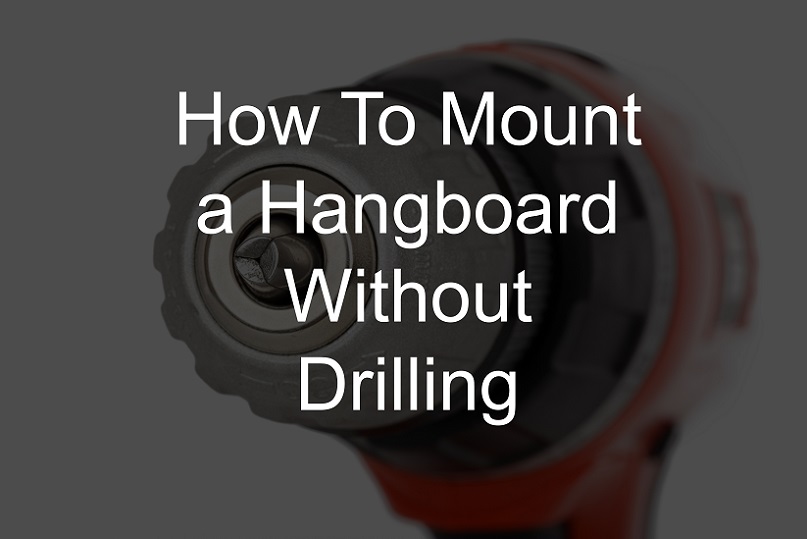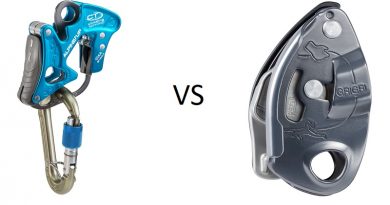Finding the right helmet is a vital part to the rock climbing experience. Simply put, without the right helmet, you won’t feel as secure and confident as you should while climbing. That’s because the wrong helmet can impede your security, hamper your comfort, and generally make climbing less of a rewarding experience.
For this reason, you’ll want to pay extra attention to what model you buy when you purchase your helmet. There are a number of helmets currently on the market, each with slightly different specs and advantages. And while I haven’t tried every rock climbing helmet out there, I’ve done my fair share of research for my own climbing purposes.
Today, I’d like to talk about one of the more interesting helmets I’ve come across: the Petzl Vertex Helmet. Part of Petzl’s professional line, the Vertex is a hard-shell helmet technically meant for more heavy-duty use (think construction). Still, it’s become somewhat of a popular item amongst climbers who are looking for a more secure way to protect themselves while on the rocks.
In this guide, I’ll go over what it is that you want in a rock climbing helmet, as well as analyze the specs of the Vertex Vent to see its pros and cons. Through this dissection, I hope you’ll get a better sense of whether or not the Vertex Vent is right for you.
With this in mind, let’s jump right in!

What to Look For
As you might expect, there are a number of considerations you must account for when purchasing your climbing helmet. In general, climbing helmets are there to maximize your safety as you climb. For this reason, they are constructed with the goal of reducing and absorbing impact in case of a fall. Despite these noble intentions, not all climbing helmets are created equally. As such, you’ll want to pay special attention to the following factors that will ultimately influence the performance of your model:
Durability
As safety should be your number one priority with any climb, it only makes sense that your chief objective in finding a helmet is getting one that keeps you safe. Depending on your skill level, however, this may mean different things. For beginners, I always recommend ABS, hard-shell helmets that (despite weighting more) are better at protecting your head from impact in case of an accident. For more advanced climbers, lightweight, EPS-foam helmets often work just as well, though they are more likely to get dinged up during the packaging and traveling parts of your trips.
For this reason, you want to find a helmet that’s durable enough for your skill level. This usually means a helmet that will keep you safe and will hold up for months and even years to come. With a durable helmet, you can maximize the safety of your climbs and feel more secure in the event of an emergency situation.
Adjustability
Right next to durability, you want a helmet that’s easily adjustable. Why? Because you want to make sure that your helmet has a secure fit. It’s as simple as this: if your helmet doesn’t fit right to your head or wobbles and bobbles too much, it won’t keep you as safe on impact. As such, you want to make sure that whatever helmet you buy has an easy-to-use and simple-to-understand adjustability system so that you can adjust even on the fly. This will help maximize your safety and save you tons of hassle while you climb.
Comfort
Trust me: you’ll know if it’s the wrong helmet. A bad helmet leads to extreme discomfort, which can in turn lead to decreased safety during your climb. It’s imperative that you find a helmet that’s comfortable for you so that you can minimize distractions as you go. In general, there are a number of factors that go into the comfort of your helmet.
One of the biggest is ventilation. Even if you’re climbing in the chilly Himalayas, you’ll be sweating after only a few minutes. As such, you want a helmet that provides enough vents to keep your head adequately cool as you climb. The last thing you want, after all, is a sweat-induced, pervasive scalp itch as you climb crags several feet in the air.
You’ll also want to make sure that your helmet is of an acceptable weight. If you’re a beginner, there might not be much you can do (as you should always opt for durability), but in general, you’ll want to find a helmet that doesn’t bog you down too extremely. This not only slows you down but also leads to extra pressure that can make you sore and detract from your experience.
Applicability
Every helmet is limited in some form or another. For example, the most durable helmets usually turn out to be some of the heaviest, while the lightest ones typically aren’t considered as safe. Against this backdrop, you want to find the helmet that’s most applicable to your climb. If you’re going on an extensive climb where speed is the name of the game, a lighter-grade helmet is probably for you. If your route is taking you pretty high or if you simply aren’t as experienced, you probably want a heavier option. There are hybrid options that combine EPS-foam with a stronger polycarbonate shell that may serve as a more useful middle ground between these two extremes.
Finding the right helmet is about balance. You want the helmet that’s most applicable to your climb in terms of both safety and ease. By considering the factors listed above, you’re more likely to find a helmet that works for your situation.
How Does the Vertex Vent Stack Up?
With all this being said, how does the Vertex Vent rate when put up against these guidelines? In the next two sections, I’ll go over some pros associated with the helmet, as well as some cons that you’ll want to keep in mind come buying time.
Pros
Here’s what I like about the Vertex Vent:
Comfort
For all its weight, it’s actually decently comfortable. The Vertex Vent comes with CenterFit technology that allows the helmet to mold to the center of your head. Not only does this guarantee a better fit, but it keeps the helmet from dangling too much from one side to the other. This greatly increases its comfort in the eyes of some reviewers, who appreciate its stationary nature and how even it feels on their heads. CenterFit can be achieved through two side adjustment wheels that are located on either side of the helmet.
The Vertex Vent also boasts webbing suspension that allows the helmet to better conform to the shape of your head. This technology makes the helmet great even for individuals who have larger or less-traditionally shaped heads. To make things even better, it comes with adjustable ventilation in the form of shutter-vents that can be opened or closed to change ventilation levels at will.
All in all, it’s hard to knock the comfort of this helmet, at least on paper.
Durability
Perhaps the Vertex Vent’s greatest aspect, however, is its durability. As a professional model used in construction and a variety of other impact-heavy fields, the helmet is actually one of the most durable on the market. Made from ABS, polycarbonate, nylon, polyethylene, and high-strength polyester, the helmet is CE, EN 397, and ANSI certified to protect workers of dangerous jobs.
This means that it’s more than capable of keeping you protected in case of an emergency. If you’re looking for a helmet based on sheer durability alone, it’s hard to beat the Vertex Vent. The outer shell is designed to deform on impact, absorbing the blow and keeping you safe in the event that you fall.
What’s more, the Vertex Vent comes with an adjustable “ground” setting so that you can stay safe even when you’re not in the air. This is great for those who are after a bit of extra security.
Accessories
The Vertex Vent also comes compatible with a wide variety of accessories. Attach a headlamp either with a band or through mounts to give yourself a bit of extra light while you climb. The foam padding in the helmet is interchangeable for better use, and it comes with an adjustable dual chin strap that will keep you even safer as you climb.
Because it’s a professional-grade helmet, the Vertex Vent works well with a variety of other add-ons (such as nape protectors). While you likely won’t need these as you climb, they might come in handy if you ever decide to retire the helmet for upgrade to a different option.
Cons
Still, there are some aspects about this helmet that won’t be pleasing to all climbers. In this section, I’ll go over some of the major cons that individuals noted with this design. In general, these have to do with the helmet’s bulkier nature and its performance as a sports helmet.
Weight
At 490 grams, this is one of the heaviest helmets you’ll come across. And while it’s not exactly uncomfortable, this does pose a few problems. Most notably, it’s not the best helmet for extensive wear. Even if you want to go with a durable option, there are other helmets (such as the Half Dome from Black Diamond) that offer fantastic durability and safety at half the weight of the Vertex Vent. With extended use of this helmet, you may encounter some type of pain in the neck or shoulders, possibly nullifying the benefits of the belaying glasses you may have chosen to bring.
This is true not just because you’ll be climbing with nearly 500 grams of pressure on your head, but also because you’ll be carrying it to and from your climbing location. In general, you want to pack as light as possible so that you don’t overexert yourself. Carrying around the Vertex Vent is the definition of overexertion, a fact that’s made worse when you realize there’s little reason to carry it around to begin with. On a personal level, I wouldn’t recommend a helmet this heavy to anyone but an absolute beginner who is looking for maximum security during their climb.
Build
On a related note, there are problems with the build of this helmet. As a professional grade model, it’s unclear whether the Vertex Vent is a viable option for rock climbing. At its size, the helmet may serve to only slow down a climber or make the process more rigorous. While it’s undeniable that the helmet’s durability specs are appealing, the helmet as a whole may be seen as a little “too much” for more experienced climbers. I know climbers who balk at the idea of wearing helmets that weigh in at 231 grams, so I doubt the makeup of this model will be appealing to anyone who’s not a total beginner. Considering its chief function as a professional helmet, this only makes sense.
Final Thoughts
So how do I rate the Petzl Vertex Vent overall? It’s complicated. While the helmet is impressive and perhaps even overperforms in terms of safety and adjustability, it just feels a little too bulky to recommend. Even with my recommendation, I doubt too many climbers would be rushing out to buy this model. Overall, it’s simply too big and too heavy for the average climber, and this may be even more true for female climbers.
That’s not to say that the Petzl Vertex Vent is a bad helmet. In fact, if you’re a beginner or are simply looking to practice climbing safely, you can get tons of use out of this helmet. The Vertex Vent retails at a similar price to other models on the market, which is to say that it wouldn’t put you out to at least buy this as a practice device. And if you really are concerned about safety and don’t mind a bit of extra size and weight, this may just be the helmet for you.
As always, though, the best way to know if a helmet is right for you is to check it out yourself. If you think the Petzl Vertex Vent is worth a shot, try it for yourself! You may just find that it works for you!






